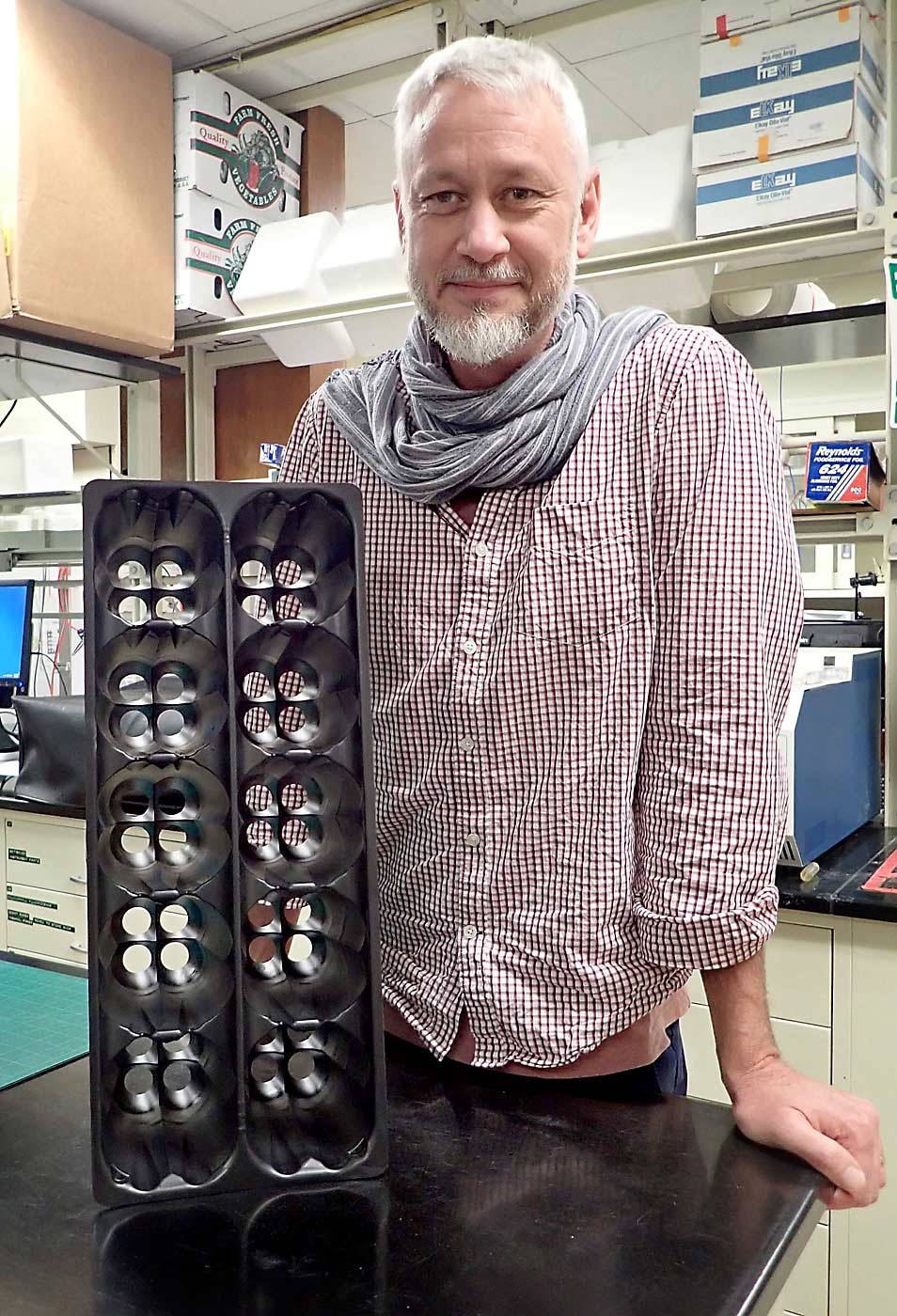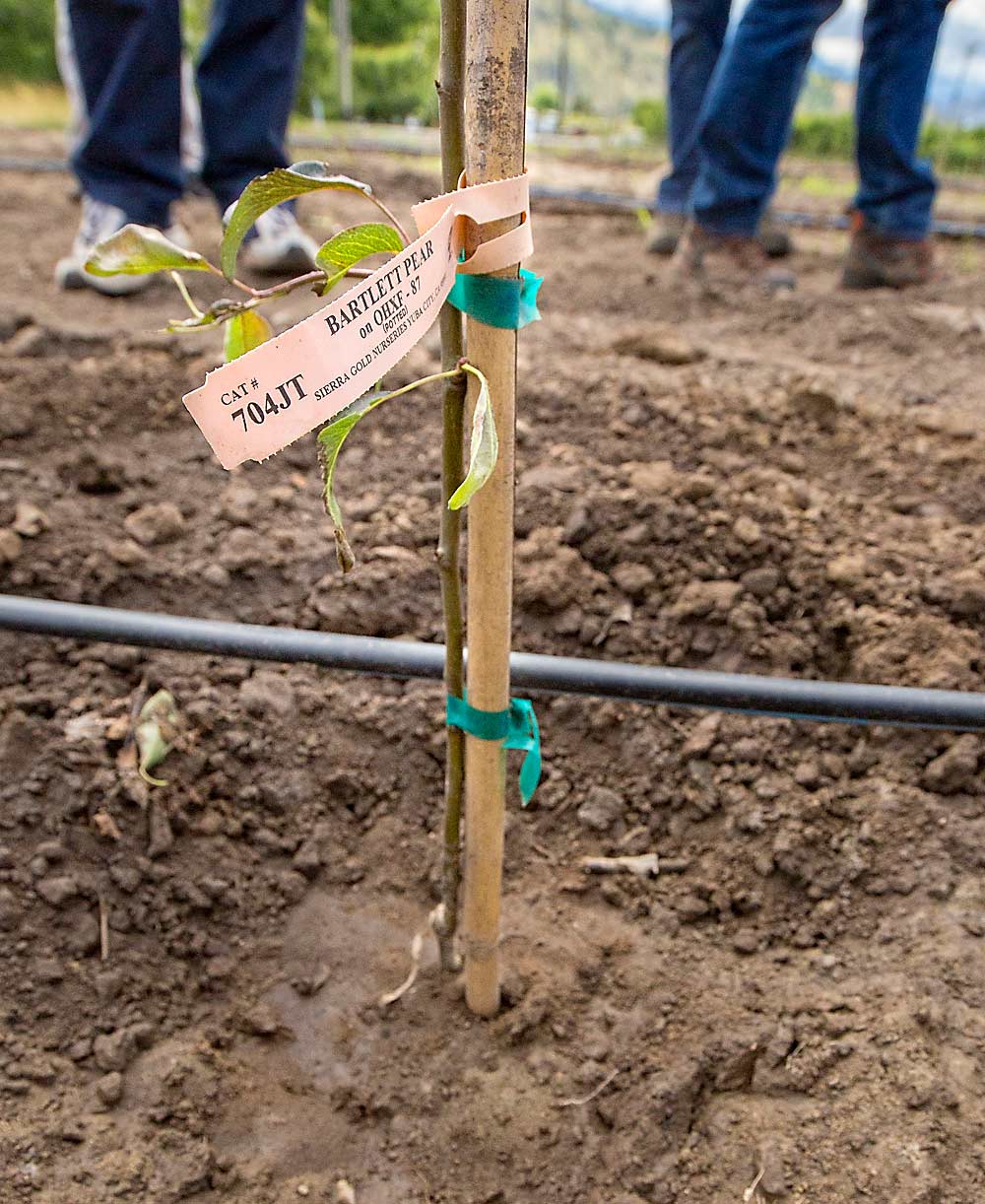
Todd Einhorn, second from right, and a group attending the 2017 Interpera 10th World Pear Conference in Wenatchee, Washington, visit one of Einhorn’s Ellepot container trials. (TJ Mullinax/Good Fruit Grower)
Apple growers are always looking for ways to get earlier crops from their young trees, and a new study from Michigan State University hints that container planting may be a step in the right direction.
The 2018 study compared container-grown trees to those grown in traditional liner beds and showed that in the first year after planting in the orchard, the container-produced trees far outperformed the liner-grown trees in fine root production and shoot growth.
“It was really night and day. You could walk through the field and easily see which trees were container-produced and which weren’t,” reported study leaders Todd Einhorn, MSU associate professor of horticulture, and Mokhles Elsysy, MSU postdoctoral research fellow.
Einhorn started experimenting with nursery containers that promise to promote more healthy root systems while at Oregon State University, and he planted trials with pears in the Northwest, as well.
Although encouraged by the results so far, he is trying to rein in his enthusiasm until he and his collaborators follow the trees for a few more years and gather more information about potential grower costs associated with the container plants.
Container vs. liner
The study used 1,200 bench-grafted trees, including 400 each of Fuji, Honeycrisp and Gala, all of which were grown on Nic.29 rootstocks. The trees were evenly split between the Michigan State University Horticulture Teaching and Research Center (“Hort Farm”) and the Sierra Gold Nursery in California.
Both sites grew the trees during the 2017 season, either in typical nursery-style liner beds in field soil or in specialized containers which were filled with a peat mix.
They used Ellepots (ellepot.com), which are made by a Dutch company and have a biodegradable paper membrane housed in a plastic container that provides air space for natural root pruning.

Todd Einhorn holds the tray portion of an Ellepot container system in his lab at Michigan State University. Einhorn found that once planted, trees grown in containers had distinct advantages over those grown in traditional liner beds, including significantly more fine root production and shoot growth. (Leslie Mertz/for Good Fruit Grower)
Most of the roots remain inside the pot, but they can also grow through the paper, Einhorn explained. That not only prevents the spiraling and girdling that can occur in typical plastic nursery pots, but the escaping roots soon die in the open air, resulting in “air pruning,” which spurs the development of fine roots inside the pot.
These fine roots likely aid in water and nutrient acquisition. He likened air pruning to a heading cut on a canopy that generates a new flush of growth.
In the spring of 2018, Einhorn’s group planted both the Hort Farm and the Sierra Gold trees at the MSU Clarksville Research Center using a high-density, spindle-style architecture. They planted the container trees in the Ellepot paper membrane and the liner-grown trees in the ground, bare-root.
Every couple of weeks afterward, the researchers pulled out a few trees from each replicate and, by scanning the roots, they determined root length and density, root size and diameter, and total dry root matter. They also measured the tree for shoot length, number of branches and trunk size.
“The goal was to see if we generated more fine root production in the Ellepot, and whether that necessarily meant that we had more growth or earlier canopy development in the field,” Einhorn said.
More roots, more growth
The Ellepot-grown trees far exceeded the liner-grown, bare-root trees.
“In the containers, generally speaking, there were 40 percent more fine roots than in the bare-root trees, and in some cases, it was 100 percent more, so we doubled the fine root production in the containers. It was tremendous. Just really amazing,” Einhorn said.
However, he noted, total root dry matter content was similar between the systems, due to greater nonfine root production of the liner-produced trees.
Shoot growth of container trees was also superior.
“For the MSU plants, for instance, we had an astronomical increase for Fuji and Gala — practically two times the amount of growth in Ellepot trees over the bare-root trees,” Einhorn said.
The researchers also found 50 percent more in Honeycrisp compared to the bare-root trees.
“It made sense that intact root systems would undergo less transplant shock, and lead to more growth than bare-root trees, and we were able to measure that all the way through the season,” he said.
Growth of the leader in Ellepot trees was approximately 50 percent greater for Fuji and Gala, but only slightly more for Honeycrisp, he said, and this was “due to the influence of more shoots competing with the growth of the leader.”
The big question now is whether the improved root and shoot growth will carry into 2019 and beyond.
“The container trees certainly have a jump, and if stresses don’t develop, you would expect, fitness-wise, that they’re ahead of the game all the way,” Einhorn said.
At the same time, the bare-root trees will presumably head into 2019 with plenty of reserves, so they may catch up. “That’s why this is a multiyear study,” he said.

One of the container-grown pear trees in Einhorn’s tests in Wenatchee, Washington, in 2017, as indicated by the “potted” notation on the label. (TJ Mullinax/Good Fruit Grower)
Pots of gold?
In addition to following the trees at least through the first crop, Einhorn’s group continues to study the root architecture of the container trees and will be investigating how well the roots expand out of the Ellepots.
Concurrently, the researchers will follow container trees planted in a commercial orchard in the Grand Rapids fruit region of Michigan, and trees planted in sandy soils at the Northwest Michigan Horticulture Research Center to see how they fare over the next few years, as well.
Einhorn also wants to quantify the cost differences between the two systems, such as the potential added expense of container trees and early returns, by eventually assessing flowering and first yields in the two systems. “Earlier canopy development should lead to higher early yields and greater profitability,” Einhorn said.
He is also seeking funding to look into different growing options for container trees, including fall versus spring planting, the effect of removing the paper pot before planting and the use of different rootstocks.
“At this point, it looks like these trees could potentially produce a more uniform orchard that fills its space better,” he said. “And that is part of the objective: if we get more growth in the nursery from these trees, what does that mean after one year in the orchard, or two years, or three years?
“We’re going to follow that out until the first cropping years to see if the returns pencil out to justify the cost. That’s the question for growers, and that’s really the most important factor.”
Funding for this study came from the Michigan Apple Commission, with additional support from Ellepot and Sierra Gold Nursery. •
—by Leslie Mertz
Correction: An earlier version of this story incorrectly identified Todd Einhorn in a photo caption. Good Fruit Grower regrets the error.






Leave A Comment